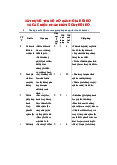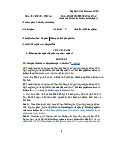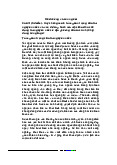





Preview text:
SOCIOLINGUISTICS
Full Name: Hoang Thi Diem Xuan
Class: Dak Lak Cong thuong Number ID: 705A400043
TOPIC 3: EXAMINE THE DIFFERENCES BETWEEN THE
VIETNAMESE SPOKEN IN HANOI AND ITS NEIGBORING AREAS AND
THE VIETNAMESE SPOKEN IN THE MEKONG DELTA. WHY DO YOU
THINK THERE ARE SUCH DIALECTAL EVIDENCE?
The article introduces Vietnamese dialect variation and focuses specifically on
the differences between Vietnamese spoken in Hanoi and its neigboring areas from
Vietnamese spoken in the Mekong Delta. Provides background information on the
importance of dialects in Vietnam and their influence on regional identity and
cultural diversity. Besides, learn the linguistic differences between the two regions
and find out the reasons behind these dialect variations.
I. Overview of Vietnamese Dialects
According to researchers Dai Xuan Ninh, Nguyen Duc Dan, Nguyen Quang,
and Vuong Toan, dialect "is a form of language with a separate lexical,
grammatical and phonological system, which is applied in a wide range of regions.
land religion, or basic society rather than language. As a system of symbols and
association rules that have a common origin with another system that is considered
a language (for the whole nation), the dialects (some people call them dialects,
dialects) are firstly different from each other. in pronunciation, then vocabulary”
[1; p.275]. The author of The Dictionary of Linguistics has a similar view when
viewing dialects as: "A distortion of a language used as a means of communication
by people who are firmly entrenched in divisions. with each other in a community
that is unified in terms of territory, social status or occupation” and divide dialects
into territorial dialects, social dialects [2; p.221]. From that, it can be understood
that territorial dialects are its regional geographical variations, many of which are
dialects, which are variations of dialects in narrower geographical areas, such as
provinces and districts. , commune or village. The system of language variations
used by different classes of people according to the relationship of age, level,
status, gender, and occupation is called social dialect.
Although there are many different conceptions, but we can realize that dialect
is the variation and form of existence in terms of phonetics, vocabulary, grammar
of the national language in a territory. or some society narrower than language.
Dialect is a historical phenomenon, it was born as an inevitable due to the
development and change of language along with the development of society. The
use of the dialect is increasingly narrow. Dialect is a variation of the national
language in the development of the national language. Although dialects are
different from the language of the whole people in some respects, to some extent,
on the basis of this, the system of phonetic structure, vocabulary, and grammar
between the dialects and the language of the whole people is the same. Dialect is a
system of variations of the language of the entire population that is limited in its scope of use.
Dialect is one of the manifestations of the diversity of national languages.
Therefore, the relationship between the national language and the dialect is the
relationship between the general and the particular, between the constant and the
variable, between the abstract and the concrete.
Currently, there are many different views on the territorial dialect zoning of
Vietnamese. In which, I agree with the way of dividing into three territorial dialect
regions as the opinion of the majority of researchers: Northern dialect region,
Central region dialect, Southern dialect region.
II. Characteristics of Vietnamese Spoken in Hanoi and its Neighboring Areas
The Northern Vietnamese accent is used in the Red River Delta
region including Hanoi (the capital), Haiphong, and the cities or provinces in the
Northeast and Northwest of the Red River Delta. The Northern dialect, especially
the Hanoi accent is used extensively in the national TV news. It has been
considered as the standard Vietnamese language but some people from the South of
Vietnam may argue about that. In the Northern accent, six tones are pronounced
clearly, especially the low rising tone (thanh Hỏi) and the high broken tone (thanh
Ngã). The vocabulary used in the Northern accent, especially in Hanoi, is
considered the official language and used in formal documents.
1. Characteristics of Vietnamese Spoken in Hanoi
Hanoi's accent is typical, typical for the voice of the Red River basin
provinces, but the pronunciation is softer, softer, "round and clear", with a slight
pronunciation of the first consonants and the clearly distinguish the contours of the
6 tones, especially there is a very flexible, sweet and graceful inflection in the bars.
These bars distinguished from each other according to two basic criteria:
contours and pitches. The system tone is described both on the auditory perception
and through the experimental analysis, it has been shown that this is the tone
system that most fully emonstrates the characteristics of the tone. It is one of the
basic building blocks so the gentle resonance for the voice of Hanoians.
The first consonant system in the original Hanoi language has only 19
consonants. Accompaniment /-w-/ original Hanoian fully shows phonetic features
of Vietnamese accompaniment. The main sound system in Hanoi language fully
reflects Characteristic of the main sound in the Vietnamese language of all people.
This system consists of 16 phonemes, including 13 single vowels and 3 diphthongs.
Linguist Nguyen Van Khang said that in fact, Hanoi language does not
distinguish between "ch - tr", "r - d", but Hanoi language distinguishes 6 clearly.
The last syllables: “ng, nh” like: “me, thang”… are pronounced clearly.
2. Ha noi’s Neighboring Areas
In the Northern accent, six tones are pronounced clearly, especially the low
rising tone (thanh Hỏi) and the high broken tone (thanh Ngã).
Following consonants in the Vietnamese language are pronounced quite
similarly in the Northern accent:
D, GI, R are pronounced as /dz/ in ‘jingle’ or ‘Jack’.
S, X are pronounced as /s/ in ‘six’ or ‘single’.
TR, CH are pronounced as /ch/ in ‘church’ or ‘channel’.
III. Characteristics of Vietnamese Spoken in the Mekong Delta
The South of Vietnam consists of two regions: the Southeast or the East has 5
provinces and 1 city; The Mekong Delta, also known as the Southwest or the West, has 12 provinces and 1 city.
In the Mekong Delta region, the dialect is quite evident in the speech of the
people and in literary works. It creates the unique identity of the people here. In
terms of phonetics, grammar, semantics and expression style, the Mekong Delta
dialects as well as dialects in other localities have interference, absorption and
transformation between regions where residents bring their own follow in the
process of going "open the realm".
If in the North, Hanoi language is different from Thanh Hoa, Nghe An, Ha
Tinh, etc., in the South, Saigon and 13 provinces and cities in the Mekong Delta
are generally not much different. If most of the Northern provinces call "cái bát",
Nghe An and Ha Tinh call it "cái đọi", then in the South it is called "cái chén".
If in the northern provinces, they call their father – mother: cha - mẹ, bố - mẹ,
thầy - u, nơi gọi là cậu - mợ, bố - bầm, thầy - bu, ải – êm (Thai people) ... then in
the South it is called ba - má, tía - dú.
On the contrary, there are some words in the North and Central region called
by one name, such as “thuyền” or “đò”, but in the South, there are many different
names to indicate the characteristics, uses, and sizes of each type. participating in
water transport, such as: “tàu”, “ghe”…
The most incorrect pronunciation of the first consonant is the "r" consonant,
often pronounced as "g". The Southern people pronounce it: “Con cá gô (rô) bỏ
trong gổ (rổ) nhảy gồ gồ (rồ rồ), hoặc Gau găm, gau ghém, gau gừng (rau răm, rau
ghém, rau vừng)”. This pronunciation is almost common in the Mekong Delta.
From Tay Ninh to Long An, down to Dong Thap, An Giang, Kien Giang...
often pronounce "r" into "d". For example: rau răm thành dao dăm, cá rô thành cá
dô… rõ ràng thành dõ dàng. Especially in Ben Tre province (except for 2 districts
of Cho Lach and Binh Dai), the consonant "tr" is pronounced as "t". For example:
cây tre, cây trúc thành cây te, cây túc. The old Go Cong area (including the
districts of Cho Gao, Go Cong Dong, Go Cong Tay, Go Cong town, Tien Giang
province and Can Duoc, Can Giuoc in Long An province) has the pronunciation of
"ng" to "qu". For example: ông ngoại thành ông quại.
The regions of Binh Duong, Binh Phuoc, and Tay Ninh have the
pronunciation of "th" to "kh". For example: cái thùng thành cái khùng, đi
thẳng thành đi khẳng.
In the Mekong Delta, there is also a phenomenon of pronunciation loss of
accompaniment or loss of main vowels, only keeping the accompaniment vowels.
Such as: đoàn viên, đoàn kết thành đòn viên, đòn kết hoặc đàn viên, đàn kết.
In the Mekong Delta, the final consonant is pronounced regardless of “n” and
“ng”, “c” and “t”. For example: cục than thành cục thang, cái thang thành cái
than; lụt và lục, lang và lan… Pronounce the final semi-syllable i and y without
distinction. For example: mái và máy.
IV. Comparison of Hanoi and Mekong Delta Dialects
The difference in dialect is based on many factors: accent (phonetics),
vocabulary and way of speaking, application in private communication (compared
to the national language). There are many differences between Southern and
Northern languages, and Hanoi is the typical expression of Northern language. The
most noticeable is the phonetic side.
These are groups of two-factor isotopic compound words that each region
chooses an element (before or after) to use, but after all, the semantics of those two
elements are identical. For example, this is a combination of two tones, but the
Southern language (the Mekong Delta) chooses the first element and the Northern
language (Hanoi) chooses the second element: “Dơ bẩn”, “đau ốm”, “lời lãi”, “bao
bọc”, “mai mối”, “hư hỏng”, “dư thừa”, “kêu gọi”, “hình ảnh”..
And here are the opposite combinations, Northerners choose the first factor,
Southerners choose the following: “Đón rước”, “lừa gạt”, “lau chùi”, “chăn mền”,
“chậm trễ”, “tìm kiếm”, “vâng dạ”, “đùa giỡn”, “thuê mướn”, “mau lẹ”…
In particular, the Hanoi language has imported many "foreign" elements to
enrich its language. The French entered Vietnam in 1858, but mainly in political,
economic and cultural centers, especially big cities (Hanoi, Saigon, Hue...). The
most obvious is through books and newspapers (published in Hanoi, the main
character is Ha Thanh) that we can say that, in the Vietnameseization of French,
the great public belongs to Hanoi.
V. Factors Influencing Dialectal Variations
Due to the discontinuity in time and space in the historical development of
Vietnamese, there has been a difference in regional dialects, forming dialects.
The formation of Vietnamese dialects due to geographical, historical,
economic and cultural reasons. In addition, there are other causes such as: social causes, linguistic causes… Conclusion:
Hanoi language compared with major dialect regions (Southern, Northern,
Central, etc.) has many differences and continues to be different. But their
boundaries are being pulled closer to the co-language of the Vietnamese subject. It
is a normal phenomenon and a positive factor of development. However, there are
many other elements (phonetics, many separate words, etiquette...) of the Hanoi
language that are still preserved from generation to generation. That is the
sustainability, making the unique beauty of Hanoi language today.
In the current context of strong economic, trade, cultural and information
exchanges, many words that were originally "specialties" of a region have now
been integrated into "properties" of the country. common language of the people.
In this trend, the words of the Mekong Delta dialect, the Hanoi dialect imported
into the Vietnamese language are the most obvious: “bột giặt, kem giặt (thay cho
xà phòng bột, xà phòng kem), gạch bông, bông tai (gạch hoa, hoa tai), máy lạnh
(điều hòa nhiệt độ), bà bầu (bà chửa), chỉ, cây (vàng) (đồng cân, lạng (vàng)), quậy
(phá), nhậu nhẹt (ăn uống, bia rượu), lì xì (mừng tuổi), nước tương (xì dầu), nhà
thuốc/ nhà sách (cửa hàng thuốc/ cửa hàng sách), v.v.”



